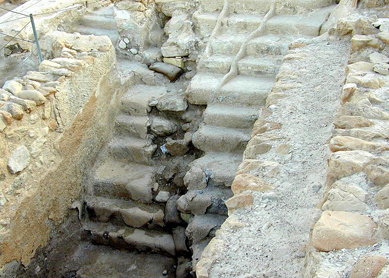The biblical term qdš is traditionally taken to mean “sacred.” The King James Bible translates it this way 90 percent of the time, using the English words “holy,” “sanctified,” “consecrated,” “hallowed,” and “sanctuary.” Qdš describes God and all that is associated with God: the sanctuary and related cult objects, the priesthood, and also the people and land of Israel. Understanding qdš as a way of describing God’s sacredness, in binary opposition to ordinary or profane existence, has been a keystone of the history of interpretation in Jewish and Christian usage of the Hebrew Bible. However, the term may have had a less rigid range of meaning in ancient Israel.
How should qdš be translated?
Qdš appears in two contexts in the Hebrew Bible. It is used sporadically in thirty books, where it describes an essential aspect of God. Additionally, it appears in the books of Leviticus (18 percent), Ezekiel (12 percent), Exodus (12 percent), and Numbers (10 percent), where it is typically associated with the Israelite cult and opposed by terms that are traditionally translated as “profane” and “unclean.” In the cultic context, anthropologist Mary Douglas first notes that the Israelite cult requires physical perfection of objects and people. For example, no priest who bears a physical defect is allowed to approach the altar or to sacrifice to God (Lev 21:17–23). Douglas concludes that “wholeness” is an essential attribute of qdš. Saul M. Olyan extends this argument with reference to altar stones, which must be whole and not cut by tools (Exod 20:25, Deut 27:5–6). Similarly, Susan Niditch appeals to the concept of wholeness to explain why priests are not allowed to cut their hair or flesh during mourning and the high priest is allowed to have neither loosened hair nor torn garments (Lev 21:5, Lev 21:10). Niditch argues that priests’ qdš requires that they have intact bodies and hair. Thus, wholeness is an essential aspect of the ancient Israelite concept of qdš.
Although the translation “holy” suggests an absolute state of being, it is more accurate to understand qdš as operating along a continuum of wholeness. Modern gender studies indicate that the ancient Israelites understand the male body to be whole, intact, and closed, whereas the female body was considered to be incomplete, compromised, and porous. Thus, although all Israelites are qdš (e.g., Lev 19:2), the intact male body is best suited to approach God because it is considered to be more qdš. Furthermore, the closer one approaches to God, the more intact he must be. Jeffery Stackert and Jeremy Schipper argue that blemished priests cannot approach the altar because they risk compromising that which is qdš (Lev 21:23). Other priestly males may approach the altar, but are cautioned not to do anything that might make them less whole (e.g., see the priestly restrictions in Lev 21). Only the high priest is allowed to enter the innermost sanctum where God resides. Since he approaches most closely to God, he must be the most careful not to breach his own qdš (Lev 21:10–15), so as to avoid compromising that of God.
The “wholeness” aspect of qdš accounts for rules governing priests’ mourning, marriage, sacrificing, and eating of holy foods (e.g., Lev 21:1–23) and underlies the larger corpus of cultic regulations directed at priests and non-priests. Modern translations continue to use some form of the word “sacred,” because English does not have a word that captures the total meaning of qdš as it was conceived in the ancient context. However, it is important to bear in mind that, to the ancient Israelites, “holy” is not a simple opposite of “profane” but bears a wider set of connotations.
See also the related word study on “profane.”
Bibliography
- Dolansky, Shawna. “A (W)Ḥol(e)(y) Breach: Philology, Gender, and Meaning.” Hebrew Bible and Ancient Israel 8 (2019): 399–415.
- Douglas, Mary. “The Abominations of Leviticus.” Pages 51–71 in Purity and Danger: An Analysis of Concepts of Pollution and Taboo. London: Taylor & Francis, 2002.
- Niditch, Susan. My Brother Esau Is a Hairy Man: Hair and Identity in Ancient Israel. New York: Oxford University Press, 2008.
- Olyan, Saul. “Mary Douglas’s Holiness/Wholeness Paradigm: Its Potential for Insight and its Limitations.” The Journal of Hebrew Scriptures 8 (2008): art. 10, pp. 1–9.






